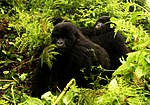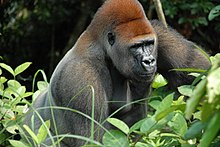Distribution and habitat
Gorillas have a patchy distribution. The range of the two species is separated by the Congo River and its tributaries. The western gorilla lives in west central Africa, while the eastern gorilla lives in east central Africa. Between the species, and even within the species, gorillas live in a variety of habitats and elevations. Gorilla habitat ranges from montane forests to swamps. Eastern gorillas inhabit montane and submontane forests between 650 and 4,000 m (2,130 and 13,120 ft) above sea level. Mountain gorillas live in the montane forests at the higher ends of the elevation range, while eastern lowland gorillas live in submontane forests at the lower ends of the elevation range. In addition, eastern lowland gorillas live in montane bamboo forests, as well as lowland forests ranging from 600–3,308 m (1,969–10,853 ft) in elevation. Western gorillas live in both lowland swamp forests and montane forests, and elevations ranging from sea level to 1,600 m (5,200 ft). Western lowland gorillas live in swamp and lowland forests ranging up to 1,600 m (5,200 ft), and Cross River gorillas live in low-lying and submontane forests ranging from 150–1,600 m (490–5,250 ft).
Nesting
Gorillas construct nests for daytime and night use. Nests tend to be simple aggregations of branches and leaves about 2 to 5 ft (0.61 to 1.52 m) in diameter and are constructed by individuals. Gorillas, unlike chimpanzees or orangutans, tend to sleep in nests on the ground. The young nest with their mothers, but construct nests after three years of age, initially close to those of their mothers. Gorilla nests are distributed arbitrarily and use of tree species for site and construction appears to be opportunistic. Nest-building by great apes is now considered to be not just animal architecture, but as an important instance of tool use.
Food and foraging
 A gorilla's day is divided between rest periods and travel or feeding periods. Diets differ between and within species. Mountain gorillas mostly eat foliage, such as leaves, stems, pith, and shoots, while fruit makes up a very small part of their diets. Mountain gorilla food is widely distributed and neither individuals nor groups have to compete with one another. Their home ranges average 3–15 km2 (1.16–5.79 mi2), and their movements range around 500 m (0.31 mi) or less on an average day. Despite eating a few species in each habitat, mountain gorillas have flexible diets and can live in a variety of habitats.
A gorilla's day is divided between rest periods and travel or feeding periods. Diets differ between and within species. Mountain gorillas mostly eat foliage, such as leaves, stems, pith, and shoots, while fruit makes up a very small part of their diets. Mountain gorilla food is widely distributed and neither individuals nor groups have to compete with one another. Their home ranges average 3–15 km2 (1.16–5.79 mi2), and their movements range around 500 m (0.31 mi) or less on an average day. Despite eating a few species in each habitat, mountain gorillas have flexible diets and can live in a variety of habitats. Eastern lowland gorillas have more diverse diets, which vary seasonally. Leaves and pith are commonly eaten, but fruits can make up as much as 25% of their diets. Since fruit is less available, lowland gorillas must travel farther each day, and their home ranges vary from 2.7–6.5 km2 (1.04 to 2.51 mi2), with day ranges 154–2,280 m (0.096–1.417 mi). Eastern lowland gorillas will also eat insects, preferably ants. Western lowland gorillas depend on fruits more than the others and they are more dispersed across their range. They travel even farther than the other gorilla subspecies, at 1,105 m (0.687 mi) per day on average, and have larger home ranges of 7–14 km2 (2.70–5.41 mi2). Western lowland gorillas have less access to terrestrial herbs, although they can access aquatic herbs in some areas. Termites and ants are also eaten.
Eastern lowland gorillas have more diverse diets, which vary seasonally. Leaves and pith are commonly eaten, but fruits can make up as much as 25% of their diets. Since fruit is less available, lowland gorillas must travel farther each day, and their home ranges vary from 2.7–6.5 km2 (1.04 to 2.51 mi2), with day ranges 154–2,280 m (0.096–1.417 mi). Eastern lowland gorillas will also eat insects, preferably ants. Western lowland gorillas depend on fruits more than the others and they are more dispersed across their range. They travel even farther than the other gorilla subspecies, at 1,105 m (0.687 mi) per day on average, and have larger home ranges of 7–14 km2 (2.70–5.41 mi2). Western lowland gorillas have less access to terrestrial herbs, although they can access aquatic herbs in some areas. Termites and ants are also eaten.
Gorillas rarely drink water "because they consume succulent vegetation that is comprised of almost half water as well as morning dew", although both mountain and lowland gorillas have been observed drinking.
Behaviour
Social structure
Gorillas live in groups called troops. Troops tend to be made of one adult male or silverback, multiple adult females and their offspring. However, multiple-male troops also exist. A silverback is typically more than 12 years of age, and is named for the distinctive patch of silver hair on his back, which comes with maturity. Silverbacks also have large canine teeth that also come with maturity. Both males and females tend to emigrate from their natal groups. For mountain gorillas, females disperse from their natal troops more than males. Mountain gorillas and western lowland gorillas also commonly transfer to second new groups.
Mature males also tend to leave their groups and establish their own troops by attracting emigrating females. However, male mountain gorillas sometimes stay in their natal troops and become subordinate to the silverback. If the silverback dies, these males may be able to become dominant or mate with the females. This behaviour has not been observed in eastern lowland gorillas. In a single male group, when the silverback dies, the females and their offspring disperse and find a new troop. Without a silverback to protect them, the infants will likely fall victim to infanticide. Joining a new group is likely to be a tactic against this. However, while gorilla troops usually disband after the silverback dies, female eastern lowlands gorillas and their offspring have been recorded staying together until a new silverback transfers into the group. This likely serves as protection from leopards.
The silverback is the center of the troop's attention, making all the decisions, mediating conflicts, determining the movements of the group, leading the others to feeding sites, and taking responsibility for the safety and well-being of the troop. Younger males subordinate to the silverback, known as blackbacks, may serve as backup protection. Blackbacks are aged between 8 and 12 years and lack the silver back hair. The bond that a silverback has with his females forms the core of gorilla social life. Bonds between them are maintained by grooming and staying close together. Females form strong relationships with males to gain mating opportunities and protection from predators and infanticidal outside males. However, aggressive behaviours between males and females do occur, but rarely lead to serious injury. Relationships between females may vary. Maternally related females in a troop tend to be friendly towards each other and associate closely. Otherwise, females have few friendly encounters and commonly act aggressively towards each other.
Females may fight for social access to males and a male may intervene. Male gorillas have weak social bonds, particularly in multiple-male groups with apparent dominance hierarchies and strong competition for mates. Males in all-male groups, though, tend to have friendly interactions and socialise through play, grooming, and staying together, and occasionally they even engage in homosexual interactions. Severe aggression is rare in stable groups, but when two mountain gorilla groups meet, the two silverbacks can sometimes engage in a fight to the death, using their canines to cause deep, gaping injuries.
Competition
One possible predator of gorillas is the leopard. Gorilla remains have been found in leopard scat, but this may be the result of scavenging. When the group is attacked by humans, leopards, or other gorillas, an individual silverback will protect the group, even at the cost of his own life.
Reproduction and parenting
Females mature at 10–12 years (earlier in captivity), and males at 11–13 years. A female’s first ovulatory cycle occurs when she is six years of age, and is followed by a two-year period of adolescent infertility. The estrous cycle lasts 30–33 days, with outward ovulation signs subtle compared to those of chimpanzees. The gestation period lasts 8.5 months. Female mountain gorillas first give birth at 10 years of age and have four-year interbirth intervals. Males can be fertile before reaching adulthood. Gorillas mate year round.
Females will purse their lips and slowly approach a male while making eye contact. This serves to urge the male to mount her. If the male does not respond, then she will try to attract his attention by reaching towards him or slapping the ground. In multiple-male groups, solicitation indicates female preference, but females can be forced to mate with multiple males. Males incite copulation by approaching a female and displaying at her or touching her and giving a "train grunt". Recently, gorillas have been observed engaging in face-to-face sex, a trait once considered unique to humans and bonobos.
Gorilla infants are vulnerable and dependent, thus mothers, their primary caregivers, are important to their survival. Male gorillas are not active in caring for the young, but they do play a role in socialising them to other youngsters. The silverback has a largely supportive relationship with the infants in his troop and shields them from aggression within the group. Infants remain in contact with their mothers for the first five months and mothers stay near the silverback for protection. Infants suckle at least once per hour and sleep with their mothers in the same nest.
Infants begin to break contact with their mothers after five months, but only for a brief period each time. By 12 months old, infants move up to five meters (16 feet) from their mothers. At around 18–21 months, the distance between mother and offspring increases and they regularly spend time away from each other. In addition, nursing decreases to once every two hours. Infants spend only half of their time with their mothers by 30 months. They enter their juvenile period at their third year, and this lasts until their sixth year. At this time, gorillas are weaned and they sleep in a separate nest from their mothers. After their offspring are weaned, females begin to ovulate and soon become pregnant again. The presence of play partners, including the silverback, minimizes conflicts in weaning between mother and offspring.
Communication
Twenty-five distinct vocalisations are recognised, many of which are used primarily for group communication within dense vegetation. Sounds classified as grunts and barks are heard most frequently while traveling, and indicate the whereabouts of individual group members. They may also be used during social interactions when discipline is required. Screams and roars signal alarm or warning, and are produced most often by silverbacks. Deep, rumbling belches suggest contentment and are heard frequently during feeding and resting periods. They are the most common form of intragroup communication.
For this reason, conflicts are most often resolved by displays and other threat behaviours that are intended to intimidate without becoming physical. The ritualized charge display is unique to gorillas. The entire sequence has nine steps: (1) progressively quickening hooting, (2) symbolic feeding, (3) rising bipedally, (4) throwing vegetation, (5) chest-beating with cupped hands, (6) one leg kick, (7) sideways running, two-legged to four-legged, (8) slapping and tearing vegetation, and (9) thumping the ground with palms to end display.
Credits:Wikipedia
Written By David Davidson







I always learn alot from this blog nice one!!
ReplyDeleteThanks, stay tuned
Deletenice one
ReplyDeleteThanks, stay tuned for more
DeleteStay tuned for more, Thanks!
ReplyDelete